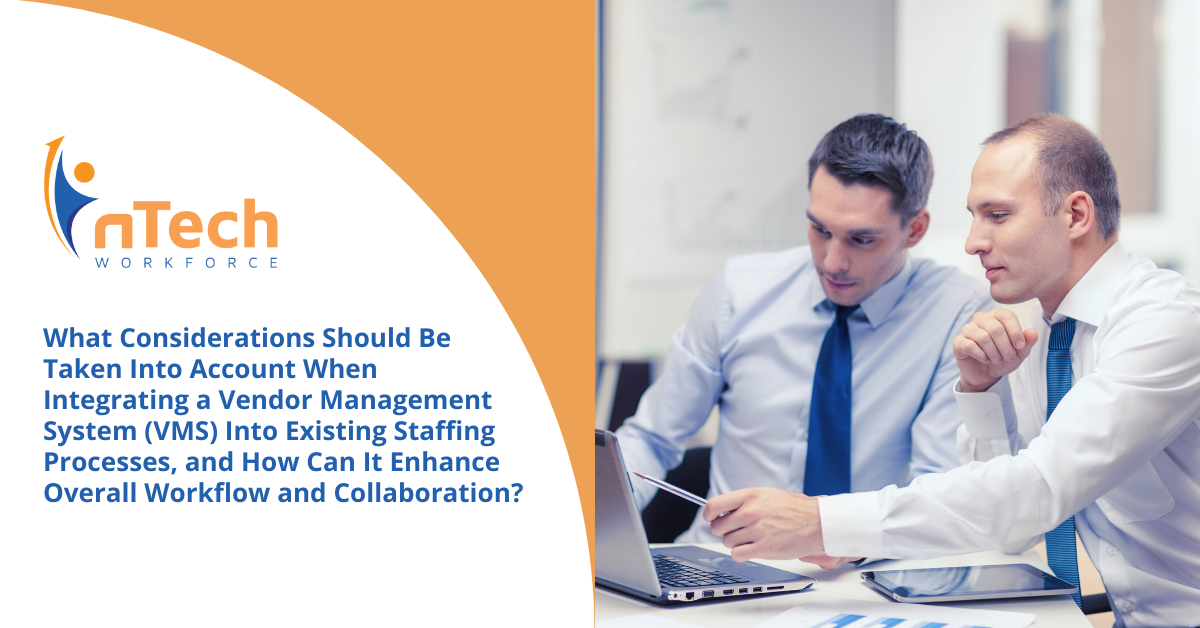What Are Strategies for Effective Career Advancement?
In our previous blog, we explored the compelling business case for investing in career advancement programs. Arthur Ransier, Director of Business...
3 min read
![]() nTech Workforce
:
Feb 29, 2024 9:00:00 AM
nTech Workforce
:
Feb 29, 2024 9:00:00 AM

In the complex world of modern business operations, integrating a Vendor Management System (VMS) into existing staffing processes presents a strategic avenue for organizations looking to streamline their contingent workforce management and workflow optimization, while bolstering collaboration across departments.
In a previous edition of the nSider Blog, a Vendor Management System (VMS) is defined as a: “Web-based software that allows contingent workforce management teams to manage staffing solutions more efficiently. The software is used for both temporary and permanent staffing services and simplifies the entire process of collecting and procuring contingent staff.” nTech Workforce shares some VMS features, including:
Rebecca Wood, Client Success Manager at nTech Workforce, shares important insights on navigating the intricacies of VMS technology integration to maximize its potential benefits for organizational growth.
According to Staffing Industry Analysts, almost 80% of companies with 1,000+ employees use a vendor management system (VMS). The decision to integrate a VMS into an organization's staffing processes necessitates a holistic assessment of needs, goals, and stakeholder perspectives.
"Before you hit ‘Go’ on a VMS, ask yourself about who’s involved and the goals that would make an implementation successful," Wood highlights. The integration process must be aligned with the organization's objectives, whether it's to:
The security of personal information stands out as a vital consideration. Wood advises: "Ensure the VMS you choose has a strong web application firewall, backup procedures, regular monitoring, and other data protections." The integration should not compromise data security but should enhance it, providing a secure platform for managing staffing processes.
Furthermore, compatibility with existing systems is a critical factor. The VMS should seamlessly integrate with other HR and operational software to ensure a unified system that supports efficient data flow and accessibility. Reporting capabilities are also essential for monitoring performance and making data-driven decisions.
Wood likens the procure-to-pay cycle of contingent workforce operations to a relay race, where seamless handoffs are crucial for efficiency. "A VMS automates handoffs and eliminates the margin for error... In automating handoffs, a VMS means faster laps – or delivery times," she explains. This analogy illustrates how VMS integration streamlines the staffing process from end to end, significantly reducing the time and effort involved in manual operations and ensuring accuracy and compliance throughout.
The automation facilitated by a VMS not only accelerates delivery times but also enhances visibility and audibility, leading to higher-quality results and a more satisfied contingent workforce operations team. The centralized system provided by a VMS will act as a hub for all staffing-related activities, promoting real-time visibility, and enabling automated workflows that reduce the administrative burden.
The integration of a VMS fosters an environment of enhanced collaboration by providing a shared platform for all parties involved in the hiring process. Wood uses the metaphor of an orchestra to describe the collaborative potential of a VMS. "A VMS is like the maestro, helping organize everybody into perfect harmony," she says. This shared space allows for transparent communication and streamlines processes, ensuring that every stakeholder, from hiring managers to staffing partners, is aligned and working cohesively towards common objectives.
Real-time feedback mechanisms and transparent workflows facilitated by the VMS empower stakeholders to see the progress of hiring processes at any given moment, eliminating confusion, and fostering a sense of accountability and partnership. This improved collaboration results in stronger relationships and a more effective talent acquisition strategy.
Despite its benefits, the integration of a VMS presents challenges, such as adapting to new technology and managing the migration of data from legacy systems. Wood emphasizes the importance of selecting a VMS that aligns with both current needs and future growth, focusing on adaptability and scalability.
Wood also shares: “Change is painful enough, and nobody likes confusing instructions. Provide quality training and onboarding for users learning your new VMS. Give your stakeholders, even your staffing partners, a bit of grace and plenty of support. Host regular check-in meetings with stakeholders to ensure the VMS is making things better. Ask them how you can make operations smoother.”
Measuring the impact of VMS integration involves benchmarking performance against predefined goals and utilizing a range of metrics to assess speed, efficiency, quality, and satisfaction. Wood suggests evaluating metrics such as time-to-fill, cost-per-hire, and quality of hire, among others, to gauge the system's effectiveness. Regular feedback from all users and continuous monitoring of performance indicators are essential for understanding the VMS's value and identifying areas for further optimization.
Wood proposes: “You need to look back at the initial goals you’ve set for the implementation in partnership with your stakeholders. Be sure to benchmark performance relative to those goals before and after implementation, and regularly for years to come. As with any large transformation or implementation, performance may lag behind the initial implementation.”
The successful integration of a Vendor Management System into existing staffing processes significantly enhances organizational workflows, streamlines operations, and fosters a collaborative environment across all levels of the staffing process. Careful consideration of goals, security, system compatibility, and stakeholder engagement, alongside diligent monitoring and adaptation, is key to unlocking the full potential of a VMS. Embracing these insights leads to a more efficient, transparent, and collaborative approach to contingent workforce management in today's competitive landscape.
Visit the nSider Resource Hub to learn more about driving organizational success with the right staffing solutions.

In our previous blog, we explored the compelling business case for investing in career advancement programs. Arthur Ransier, Director of Business...

In this blog series, Arthur Ransier, Director of Business Strategy at nTech Workforce, explores the transformative impact of career advancement.

Today’s business world moves quickly. Without innovation, nearly any company can falter, leading them to fall behind the competition. With...